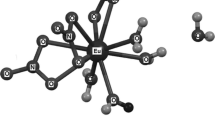Abstract
The hexahydrate of praseodymium nitrate hexahydrate Pr(NO3)3·6H2O does not show phase transitions in the range of 233–328 K when the compound melts in its own water of crystallization. It is suggested that the thermal decomposition is a complex step-wise process, which involves the condensation of 6 mol of the initial monomer Pr(NO3)3·6H2O into a cyclic cluster 6[Pr(NO3)3·6H2O]. This hexamer gradually loses water and nitric acid, and a series of intermediate amorphous oxynitrates is formed. The removal of 68% HNO3–32% H2O azeotrope is essentially a continuous process occurring in the liquid phase. At higher temperatures, oxynitrates undergo thermal degradation and lose water, nitrogen dioxide and oxygen, leaving behind normal praseodymium oxide Pr2O3. The latter absorbs approximately 1 mol of atomic oxygen from N2O5 disproportionation, giving rise to the non-stoichiometric higher oxide Pr2O3.33. All mass losses are satisfactorily accounted for under the proposed scheme of thermal decomposition.








Similar content being viewed by others
References
Merbach AE, Helm L, Toth E. The chemistry of contrast agents in medical magnetic resonance imaging. 2nd ed. Chichester: Wiley; 2013.
Decadt R, Van Der Voort P, Van Driessche I, Van Deun R, Van Hecke K. Redetermination of [Pr(NO3)3(H2O)4]·2H2O. Acta Crystallogr E. 2012;68:i59–60.
Hussein GAM, Balboul BAA, A-Warith MA, Othman AGM. Thermal genesis and characterization of praseodymium oxide from praseodymium nitrate hydrate. Thermochim Acta. 2007;369:59–66.
Melnikov P, Nascimento VA, Zanoni Consolo LZ. Thermal decomposition of gallium nitrate hydrate and modeling of thermolysis products. J Therm Anal Calorim. 2012;107:1117–21.
Melnikov P, Nascimento VA, Zanoni Consolo LZ. Computerized modeling of intermediate compounds formed during thermal decomposition of gadolinium nitrate hydrate. Russ J Phys Chem. 2012;86:1659–63.
Melnikov P, Nascimento VA, Consolo LZZ, Silva AF. Mechanism of thermal decomposition of yttrium nitrate hexahydrate Y(NO3)3·6H2O and modeling of intermediate oxynitrates. J Therm Anal Calorim. 2013;111:115–9.
Melnikov P, Nascimento VA, Arkhangelsky IV, Zanoni Consolo LZ. Thermal decomposition mechanism of aluminum nitrate octahydrate and characterization of intermediate products by the technique of computerized modeling. J Therm Anal Calorim. 2013;111:543–8.
Melnikov P, Nascimento VA, Arkhangelsky IV, Zanoni Consolo LZ, de Oliveira LCS. Thermolysis mechanism of chromium nitrate nonahydrate and computerized modeling of intermediate products. J Therm Anal Calorim. 2013;114:1021–7.
Melnikov P, Nascimento VA, Arkhangelsky IV, Zanoni Consolo LZ, de Oliveira LCS. Thermal decomposition mechanism of iron (III) nitrate and characterization of intermediate products by the technique of computerized modeling. J Therm Anal Calorim. 2014;115:145–51.
Melnikov P, Arkhangelsky IV, Nascimento VA, Silva AF, Zanoni Consolo LZ, de Oliveira LCS, Herrero AS. Thermolysis mechanism of dysprosium hexahydrate nitrate Dy(NO3)3·6H2O and modeling of intermediate decomposition products. J Therm Anal Calorim. 2015;122:571–8.
Melnikov P, Arkhangelsky IV, Nascimento VA, Silva AF, Zanoni Consolo LZ. Thermolysis mechanism of samarium nitrate hexahydrate. J Therm Anal Calorim. 2014. https://doi.org/10.1007/s10973-014-4067-x.
Melnikov P, Nascimento VA, Arkhangelsky IV, Silva AF, Zanoni-Consolo LZ. Thermogravimetric study of the scandium nitrate hexahydrate thermolysis and computer modeling of intermediate oxynitrates. J Therm Anal Calorim. 2014. https://doi.org/10.1007/s10973-014-4272-7.
Melnikov P, Arkhangelsky IV, Nascimento VA, de Oliveira LCS, Silva AF, Zanoni LZ. Thermal analysis of europium nitrate hexahydrate Eu(NO3)3·6H2O. J Therm Anal Calorim. 2016. https://doi.org/10.1007/s10973-016-6047-9.
Strydom CA, Van Vuuren CPJ. The thermal decomposition of lanthanum(III), praseodymium (III) and europium(III) nitrates. Thermochim Acta. 1988;124:277–83.
Young DC. Computational chemistry: a practical guide for applying techniques to real-world problems. New York: Wiley; 2001.
NIST Chemistry WebBook. NIST Standard Reference Database Number 69. www.http//webbook.nist/chemistry. Accessed 8 May 2016.
Huang C-H, editor. Rare earth coordination chemistry. Fundamentals and applications. Singapore: Wiley; 2010.
Manelis GB, Nazin GM, Rubtsov YT, Strunin VA. Thermal decomposition and combustion of explosives and propellants. Boca Raton: CRC Press; 2003.
Liu Y, Bluck D., Brana-Melero F. Static and dynamic simulation of NOx absorption tower based on a hybrid-kinetic equilibrium reaction model. In: Eden MR, Siirola JD, Towler GP, editors. Proceedings of the 8th international conference on foundations of computer-aided process design. Amsterdam: Elsevier; 2014.
Bibart CH, Ewing GE. Vibrational spectrum of gaseous N2O3. J Chem Phys. 1974;61:1293–9.
Gasgnier M, Schiffmacher G, Caro P. The formation of rare earth oxides far from equilibrium. J Less Com Met. 1986;116:31–8.
Wesley McMurray J. Thermodynamic assessment of the Pr–O system. J Am Ceram Soc. 2016;99:1092–9.
Tian H, Guo YN, Zhao L, Tang J, Liu Z. Hexanuclear dysprosium (III) compound incorporating vertex- and edge-sharing Dy3 triangles exhibiting single-molecule-magnet behavior. Inorg Chem. 2011;50:8688–90.
Giester G, Unfried P, Zak Z. Synthesis and crystal structure of some new rare earth basic nitrates II: [Ln6O(OH)8(H2O)12(NO3)6](NO3)2·xH2O, Ln = Sm, Dy, Er; x (Sm) = 6, x(Dy) = 5, x(Er) = 4. J Alloy Compd. 1997;257:175–81.
Acknowledgements
The authors are indebted to CNPq and FUNDECT (Brazilian agencies) for financial support.
Author information
Authors and Affiliations
Corresponding author
Rights and permissions
About this article
Cite this article
Melnikov, P., Arkhangelsky, I.V., Nascimento, V.A. et al. Thermal decomposition of praseodymium nitrate hexahydrate Pr(NO3)3·6H2O. J Therm Anal Calorim 133, 929–934 (2018). https://doi.org/10.1007/s10973-018-7177-z
Received:
Accepted:
Published:
Issue Date:
DOI: https://doi.org/10.1007/s10973-018-7177-z




